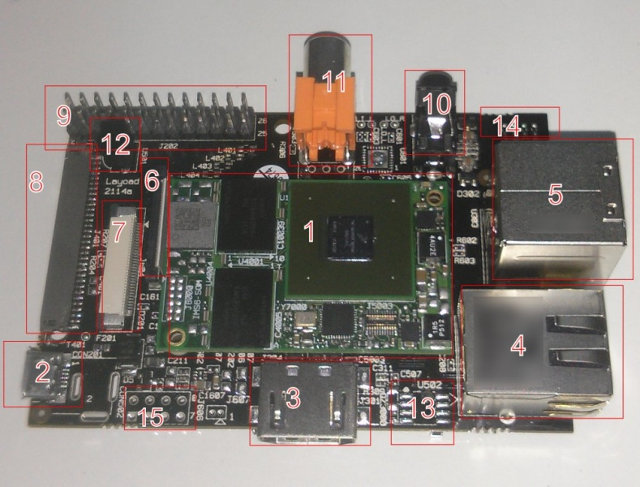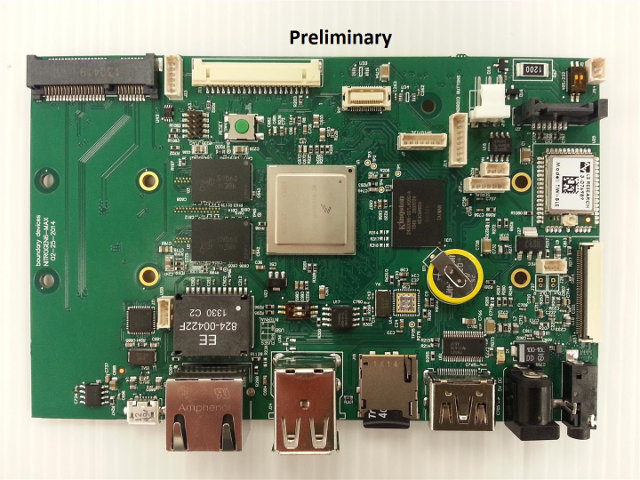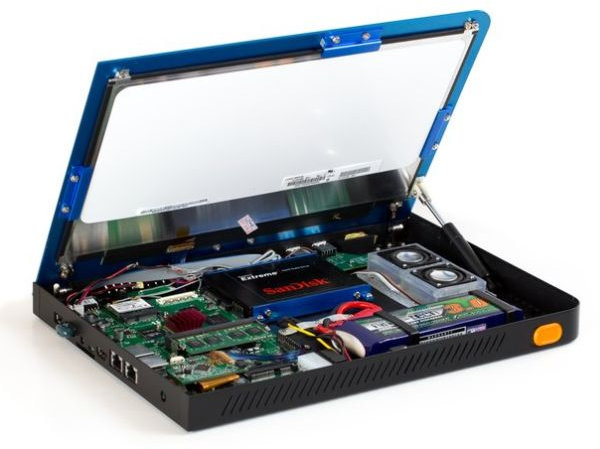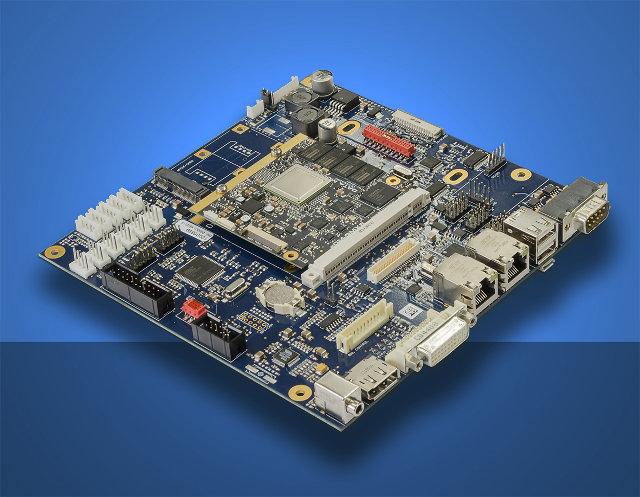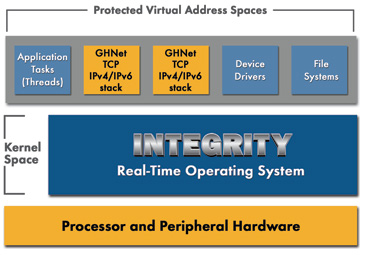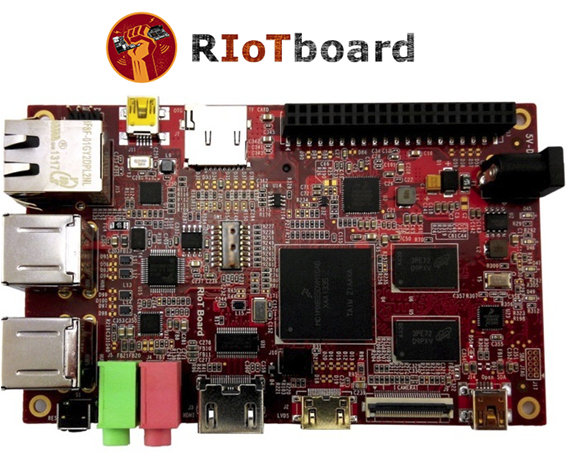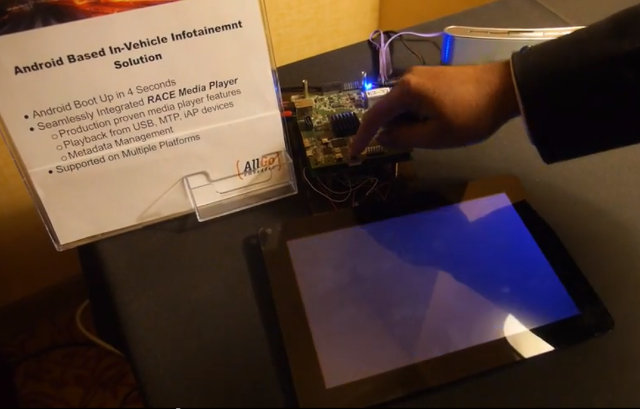Yesterday, I wrote about Banana Pi, an AllWinner A20 powered development board that’s mechanically and electrically compatible with the Raspberry Pi so that you can keep using your existing R-Pi accessories. It turns out another company is working on a similar concept. Solidrun who has brought us Cubox and Cubox-i in the past, will soon launch HummingBoard, a Raspberry Pi compatible board powered by Freescale i.MX6 solo/dual/quad SoC, bring even more power than the AllWinner A20 dual core Cortex A7 SoC found in the Banana Pi. The HummingBoard, previously known as Carrier One, is composed of a baseboard and SolidRun microSOM (micro System-on-Module) have comes with the followings specifications: SoC = Freescale i.MX6 Quad @ 1 GHz with Vivante GC2000 3D GPU. The microSoM also comes in solo and dual flavors, and although it’s likely the HummingBoard will be sold with these variants too, it’s not 100% confirmed System Memory […]
$249 Nitrogen6 MAX Development Board Features Freescale i.MX6 Quad, 4GB RAM, mPCIe Connector, and More
There are now many low cost development boards based on Freescale i.MX6 ARM Cortex A9 processors with Wandboard, Sabre Lite, UDOO, Nitrogen6X among others, all selling for less than $200. Boundary devices, the company behind Nitrogen6X board, has made a new version called Nitrogen6 MAX that maxes out the RAM to 4GB, adds a full mPCIE slot, a dual channel LVDS connector, and 4GB on-board eMMC. Nitrogen6 MAX specifications: SoC – Freescale i.MX 6Q quad core ARM Cortex A9 processor at 1GHz with Vivante GC2000 3D GPU System Memory – 4GB 64-bit DDR3 @ 532MHz Storage – 4GB eMMC, SATA connector, two micro SDHC card slots, 2MB Serial Flash Connectivity – 10/100/1G Ethernet, TiWi 802.11 b/g/n WiFi + Bluetooth BLE module Display Output – HDMI, 2x LVDS, Parallell RGB Audio I/O – HDMI, Analog (headphone/mic) audio and 2W amplified audio Camera I/F – Parallel camera port with OV5642 Interface, MIPI […]
Novena Open Source Hardware ARM Laptop Gets Crowdfunded for $1995
In 2012, Andrew Huang (“Bunnie”) decided to build an open source hardware and software laptop codenamed Novena powered by Freescale i.MX6 as a side project. The goal of the project was to be fully open source, both in terms of hardware and software, and the components have been selected so that the datasheets can be downloaded without NDA. Design has now been completed, and a crowdfunding campaign has now been launched on Crowd Supply, but since finding low cost part was not priority, you’ll have to fork $1,995 to get the complete laptop, $1,195 will get you the desktop version, and $500 the motherboard only. There’s also a version of the laptop called “Heirloom Laptop” with a hand-crafted wood and aluminum case that goes for $5,000. Let’s go through the board specs first: SoC – Freescale iMX6 Quad-core Cortex A9 CPU with NEON FPU @ 1.2 GHz. – NDA-free datasheet […]
DATA MODUL mini-ITX Board Supports Freescale i.MX6 & Intel Bay Trail-I QSeven Modules
DATA MODUL, a specialist supplier of display technology, has recently unveiled eDM-mITX-CB-Q7-Info, a mini-ITX Baseboard for ARM & x86 Qseven modules optimized to drive large panels for digital signage applications. In theory, the board should support any Qseven modules, but for now only Data Modul’s Freescale i.MX6, and Congatec conga-QA3 Intel Atom E3800 series modules have been optimized and officially certified to work with the motherboard. Precisely, the board is optimized and certified for the following modules: DATA MODUL ARM Qseven SoMs: eDM-QMX6 (i.MX6Quad) eDM-DMX6 (i.MX6Dual) eDM-DLMX6 (i.MX6Dual lite) Congatec x86 Qseven SoMs: Conga-QA3 with Atom E3845 (Quad core) Conga-QA3 with Atom E382x (Dual core). Three models: Atom E3827, E3826 or E3825. Conga-QA3 with Atom E3815 (Single core) You may have heard about EDM, a competing module standard, previously, but the eDM prefix in the ARM modules or the mini-ITX board names has nothing to do with this standard, as […]
Green Hills Software Announces ARM Cortex A50 Support for INTEGRITY RTOS and Development Tools
The latest SoCs based on 64-bit ARM Cortex A53 and A57 are not only going to be used in servers and high-end mobile devices, and some embedded applications in automotive, industrial, Mil/Aero sector, as well as the Internet of Things (IoT) will also leverage the low power, high performance of ARMv8 processors. Green Hills Software has announced their INTEGRITY real-time operating system (RTOS) and MULTI integrated development environment (IDE) will support SoCs based on ARM Cortex A50 series cores. Green Hills provide the following solutions on ARMv8 Fast Model virtual platform: INTEGRITY RTOS which comes with functional safety certifications in industrial, medical, automotive and railway, and delivers real-time determinism Green Hills C/C++ Optimizing Compilers/assembler and 64-bit toolchain MULTI 64-bit IDE debugger, MISRA C/C++ code quality adherence, profiler and other integrated tools. Only ARMv8-A is supported for now, but not ARMv8-R, destined to be used in safety-related applications in automotive and […]
$74 RIoTBoard Development Board Features Freescale i.MX 6Solo
RIoTBoard, which stands for “Revolutionizing the Internet of Things Board”, is a new Android & GNU/Linux development board sold by Element14 /Newark powered by Freescale i.MX6Solo Cortex A9 processor. The board also features 1GB DDR3 RAM, 4GB eMMC and plenty of ports including Gb Ethernet, HDMI, and more. The board can be used to design netbooks , nettops, mobile internet devices (MIDs), PDAs, portable media players (PMP) with HD video capability, portable navigation devices (PNDs), industrial control and test and measurement (T&M), and single board computers (SBCs). RIoTBoard specifications: SoC – Freescale i.MX 6Solo ARM Cortex A9 MPCore Processor @ 1 GHz with Vivante GC880 and GC320 GPUs for 3D & 2D graphics, and HD video processing unit. System Memory – 1GB DDR3 RAM Storage – 4GB eMMC, microSD and SD card slots Video Output – HDMI, LVDS, and parallel RGB interfaces Audio I/O – Analog headphone/microphone, 3.5mm audio jack […]
Linaro 14.01 Release with Linux Kernel 3.13 and Android 4.4.2
The first release of the year, Linaro 14.01, is now out with Linux Kernel 3.13 (baseline), Linux Kernel 3.10.28 (LSK), Android 4.4.2, and Ubuntu Linaro 14.01. The most important part of this release is support for Arndale Octa, which makes big.LITTLE processing code available to a low cost platform. Android 4.4.x is now on par with Android 4.3 in terms of support. Linaro has also decided to provide quarterly stable released with GCC, and Linaro GCC 4.7-2014.01 is the first quarterly stable release with the next one planned with Linaro 14.04. Here are the highlights of this release: Linaro Stable Kernel (LSK) 3.10.28-2014.01 with latest version of GTS patch set for big.LITTLE, and Android support Linux Linaro 3.13-2014.01: gator version 5.17 updated linaro-android-3.13-merge topic by John Stultz, the “Revert “PM / Sleep: Require CAP_BLOCK_SUSPEND to use wake_lock/wake_unlock” patch included uprobes v4 updated big-LITTLE-pmu topic from ARM Landing Team (LT) updated […]
AllGo Embedded Systems Android IVI System Boots in 4 Seconds
We’ve already seen several sub-second boot times for embedded Linux systems with platforms such as Beagleboard (TI OMAP 3530) and an AllWinner A10 based device, but I had never seen fast boot optimization for Android before, or I just forgot… Typically Android boots within 20 to 40 seconds on most devices, but AllGo Embedded Systems has optimized Android Jelly Bean boot time for their IVI (In-Vehicle Infotainment) platform running a media player called RACE. Charbax interviewed then at CES 2014, where they demoed the 4 seconds (actually 4.2 seconds) boot on Texas Instruments OMAP5 from reset and power, as you can see in the video below. (The video starts at 2:20 to show the demo directly). Beside Texas Instrument OMAP5, the solution is also available for Freescale i.MX6. 0xlab did some boot time optimizations for Android dropping the boot time from 30 seconds to 15 seconds. AllGo Embedded Systems did […]


